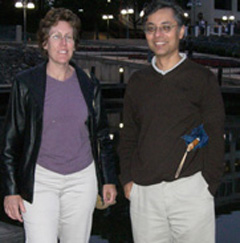ISU, UMBI researchers find most radiation-resistant microbe
September 26, 2007
Baltimore, Md. – Investigators at Idaho State University and at UMBI, the biotechnology institution of the University System of Maryland, have isolated the most radiation-resistant organisms known to science.
The latest contenders are members of a remarkable kingdom of microorganisms known as Archaea. Archaea, first discovered 30 years ago, like bacteria, have no cell nucleus, but they represent a kingdom that is closer on the tree of life to plants and animals than bacteria.
As is often the case in biotechnology, the new discoveries suggest possible applications that could prove beneficial to humans, or that may have environmental applications. For example, it may be possible in the future to confer radiation-resistance, or DNA repair in general, by transferring the genes to other organisms, such as plants.
Using advanced techniques for isolating radiation-resistant mutants, Linda C. DeVeaux, Ph.D., from ISU, and Shiladitya DasSarma, Ph.D., UMBI, and colleagues have isolated mutants that are more radiation-resistant than any other known life form discovered to date. The radiation-resistant microbes depend on at least two different pathways for their radiation-resistance.
One such pathway is shared by bacteria, while the other is found in higher organisms such as multicellular animals. The latter pathway was activated in the radiation resistant mutants. The findings will appear in the October issue of the scientific journal “Radiation Research.” Other scientists contributing to the paper include UMBI post-doctoral researcher Jochen A. Müller, ISU master’s student in microbiology Jonathon Smith, ISU Post-doctoratal researcher Jill Petrisko, and ISU physics professor and Idaho Accelerator Center director Douglas P. Wells, PhD.
Many of these Archaeans thrive in extreme environments that would be quickly lethal to other life forms—such as volcanic boiling hot springs, caustic chemicals such as acids, hydrogen sulfide, or acids or alkaline conditions so extreme that they would burn through human skin. For this reason, the microbes are known as extremophiles, or “lovers of extremes.”
The rad-resistant microbes are mutants derived from Halobacterium species NRC-1. Halobacterium are found in bodies of water that are extremely salty, and in pools that are subjected to repeated drying cycles. In these extreme environments, ultraviolet radiation from the Sun combined with salty and desiccating conditions are very hard on DNA, the genetic material. Most cell types would suffer far too much damage to the DNA under such conditions to survive.
But life will find a way, and natural selection has favored the Halobacterium NRC-1, which has evolved some remarkable methods for DNA repair. The mutants exceed the impressive radiation resistance of the natural species.
In general, extremophiles have offered unprecedented opportunities for developing new products in biotechnology. For example, studies of Thermus aquaticus, which thrives in boiling hot springs, have opened up a large market for enzymes that are now routinely used to amplify DNA sequences in forensics and biomedical research; this technique, known as PCR, has revolutionized biology, medicine, and forensics.
Before the isolation of the NRC-1 mutants, the contender for the most radiation-resistant organism has been Deinococcus radiodurans, a bacterial cell that was discovered in the 1950s as the sole survivor of canned meats that had been subjected to sterilization by lethal doses of radiation. The current champions were selected as survivors of multiple doses greater than 18,000 gray units (Gy) of radiation, considerably higher than the dose that kills half of the previous champion, D. radiodurans. For comparison, a dose of only 10 Gy is lethal to humans, and 60 Gy will kill an entire culture of E. coli, a common bacterium. One gray is equivalent to the amount of radiation in about 5,000 chest X-rays. Both Deinococcus and Halobacterium thus survive doses hundreds or thousands of times higher than those lethal to other life forms. The selected mutants of NRC-1 are even more resistant than Deinococcus.
With research centers in Baltimore, Rockville, and College Park, the University of Maryland Biotechnology Institute is the newest of 13 institutions forming the University System of Maryland. UMBI has more than 60 ladder-ranked faculty and a 2007 budget of $59 million. Celebrating the institution’s 20th year, UMBI is led by microbiologist and former biotechnology executive Dr. Jennie C. Hunter-Cevera. For more information visit http://www.umbi.org.
EDITORS NOTE: This research is featured in a Sept. 25 Washington Post story at the Web site:
http://www.washingtonpost.com/wp-dyn/content/-
article/2007/09/24/AR2007092401470.html?hpid=moreheadlines
Categories:
